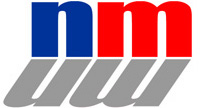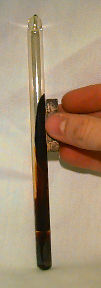

Experiment 1 - The Magnetic Liquid
Materials
- EMG-905, a mineral oil-based ferrofluid with a saturation magnetization
of 400 gauss obtained from Ferrofluidics
Corporation.
- Strong magnet (cow magnet, bar magnet, or rare earth magnet). Click here for magnet suppliers.
- Long test tube
Caution! Caution!
Caution! Caution! Caution! Caution! Caution! Caution!
The ferrofluid causes stains and is difficult to remove from skin and
fabrics. Keep the fluid off the magnet. It is virtually impossible to remove
ferrofluid after direct contact with a strong magnet.
Caution! Caution!
Caution! Caution! Caution! Caution! Caution! Caution!
Procedure
- Transfer a small amount of ferrofluid to a long test tube or other long
glass tube.
- Using a strong magnet placed outside of the tube, drag the ferrofluid up
the side wall of the glass tube. This step demonstrates effectively how the
position of the ferrofluid can be controlled with a magnetic field. (Upon
removal of the magnet, the ferrofluid tends to coat the glass. Pretreatment
of the glass tube by: 1) soaking it overnight in a strong solution of KOH
in ethanol or 2) by coating the inside with Scotchgard® spray and drying
will help the ferrofluid drain more rapidly. Several minutes may be required
for the ferrofluid to drain sufficiently so that the demonstration may be
viewed again in the same tube.)
  |
Figure 1 - Pulling ferrofluid up a tube with a strong magnet. |
Adapted from Teaching General Chemistry: A Materials Science Companion
by A. B. Ellis, M. J. Geselbracht, B. J. Johnson, G. C. Lisensky, and W. R.
Robinson. Copyright © 1993, American Chemical Society, Washington, DC
Return to Ferrofluid Main Page
Experiment 2 - Ferrofluid Spikes
Experiment 3 - The Penny Push
Exploring
the Nanoworld |
MRSEC Nanostructured Interfaces
Copyright © 2006 The Board of Regents of the University
of Wisconsin System.



